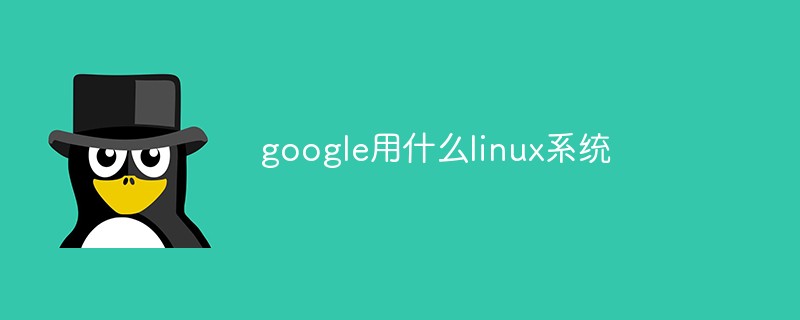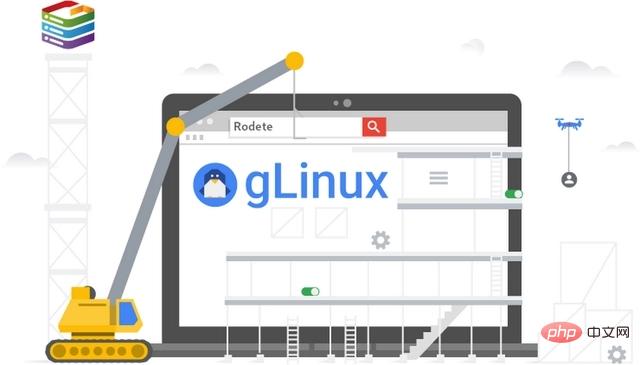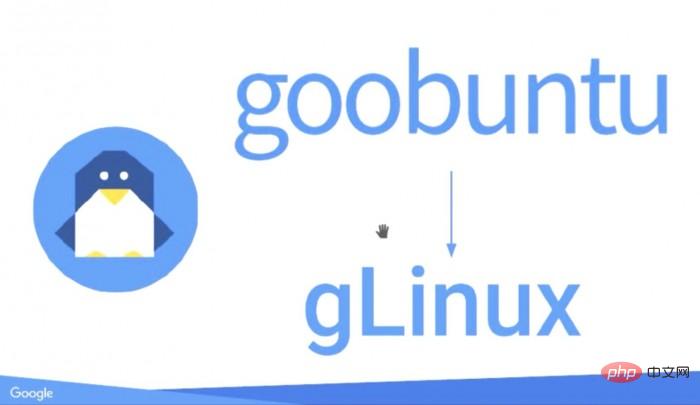What linux system does google use?
The Linux system used by Google: 1. Goobuntu, a Linux distribution used by Google for a long time, is built internally based on Ubuntu LTS; 2. gLinux, a rolling update distribution built on the Debian test branch.

#The operating environment of this tutorial: linux7.3 system, Dell G3 computer.
The Linux systems used by Google: Goobuntu and gLinux.
Goobuntu
Google uses a number of different operating system platforms internally, including Linux. Google chose to build its internal Linux distribution Goobuntu based on Ubuntu LTS, mainly because Ubuntu is user-friendly, easy to use, and provides many excellent features. Additionally, LTS will receive 2+ years of security updates from Canonical.
According to the official introduction, Goobuntu is a Linux distribution that has been used by Google for a long time. But Ubuntu LTS's two-year update cycle means Google must upgrade every one of its more than 100,000 devices before the operating system goes EOL. This is a very difficult and time-consuming job, after all, having all engineers configure their workspaces from scratch every two years is a serious blow to productivity and an irresponsible option from a financial perspective.
During each operating system life cycle, Google also faces the challenge of major version upgrades of software packages, as this may require significant changes to the software configuration. To automate this process, Google engineers wrote an unattended upgrade tool to handle many common problems. This "automated upgrade" means that most Google employees don't have to upgrade manually by reinstalling their machines and recreating all configurations. But in order to achieve this, Google needs to fully test the upgrade process and check that all major packages that have been changed continue to work (in Ubuntu, upgrades between major versions can be as many as thousands of packages). Sometimes it's difficult to provide automation in situations where package deprecation occurs and engineers have to decide how to move forward.
It is said that it usually takes Google a year to complete all Goobuntu upgrades, and the entire process is a huge pressure on the team. And many times some bugs they encounter have been fixed upstream, but these improvements are never merged into the LTS version used.
So Google turned to a rolling update distribution, but it did not choose the well-known rolling update distribution Arch Linux. Instead, it built gLinux Rodete (Rolling Debian Testing) based on the Debian test branch.

#Choose Debian because of its large community and software libraries, as well as the ability to use existing internal packages and tools in the Debian format. Moreover, Ubuntu is also based on Debian, making migration easier and smoother.
Debian’s stable branch also releases a major update almost every two years, but its test branch is updated on a rolling basis. Rolling updates mean that new versions need to be prevented as much as possible from causing disruption to existing workflows. To manage all these complex tasks of building all upstream packages from source code, Google built a workflow system called Sieve. Ensure that neither core components nor developer workflows are broken by new versions of packages by running a virtualization test suite.

gLinux
Google has decided to abandon its Ubuntu-based Goobuntu distribution and replace it with another The version called gLinux, apparently, is based on the Debian test repository.
gLinux will follow the rolling release model
If you listen to the DebConf17 talk (starting at minute 12), you will find some details about Goobuntu and gLinux, such as the former still Based on Ubuntu 14.04 LTS (Trusty Tahr), which is now based on the Debian GNU/Linux 10 "Buster" operating system and follows a rolling release model.
So why did Google move to Debian? Well, they seem intent on pushing them upstream. In other words, if they patch any security flaws or fix some bugs, these will immediately be available in the Debian repositories for all Debian GNU/Linux users to install on their computers.
Of course, this is good news for the Debian community, and even better news for the rest of the Linux community, as Google is a major contributor to the development and adoption of the Linux operating system. Google is also currently developing a new general-purpose operating system called Fuchsia OS, but has not shared details yet.
Related recommendations: "Linux Video Tutorial"
The above is the detailed content of What linux system does google use?. For more information, please follow other related articles on the PHP Chinese website!

Hot AI Tools

Undresser.AI Undress
AI-powered app for creating realistic nude photos

AI Clothes Remover
Online AI tool for removing clothes from photos.

Undress AI Tool
Undress images for free

Clothoff.io
AI clothes remover

AI Hentai Generator
Generate AI Hentai for free.

Hot Article

Hot Tools

Notepad++7.3.1
Easy-to-use and free code editor

SublimeText3 Chinese version
Chinese version, very easy to use

Zend Studio 13.0.1
Powerful PHP integrated development environment

Dreamweaver CS6
Visual web development tools

SublimeText3 Mac version
God-level code editing software (SublimeText3)

Hot Topics
 1378
1378
 52
52
 Difference between centos and ubuntu
Apr 14, 2025 pm 09:09 PM
Difference between centos and ubuntu
Apr 14, 2025 pm 09:09 PM
The key differences between CentOS and Ubuntu are: origin (CentOS originates from Red Hat, for enterprises; Ubuntu originates from Debian, for individuals), package management (CentOS uses yum, focusing on stability; Ubuntu uses apt, for high update frequency), support cycle (CentOS provides 10 years of support, Ubuntu provides 5 years of LTS support), community support (CentOS focuses on stability, Ubuntu provides a wide range of tutorials and documents), uses (CentOS is biased towards servers, Ubuntu is suitable for servers and desktops), other differences include installation simplicity (CentOS is thin)
 Centos stops maintenance 2024
Apr 14, 2025 pm 08:39 PM
Centos stops maintenance 2024
Apr 14, 2025 pm 08:39 PM
CentOS will be shut down in 2024 because its upstream distribution, RHEL 8, has been shut down. This shutdown will affect the CentOS 8 system, preventing it from continuing to receive updates. Users should plan for migration, and recommended options include CentOS Stream, AlmaLinux, and Rocky Linux to keep the system safe and stable.
 Detailed explanation of docker principle
Apr 14, 2025 pm 11:57 PM
Detailed explanation of docker principle
Apr 14, 2025 pm 11:57 PM
Docker uses Linux kernel features to provide an efficient and isolated application running environment. Its working principle is as follows: 1. The mirror is used as a read-only template, which contains everything you need to run the application; 2. The Union File System (UnionFS) stacks multiple file systems, only storing the differences, saving space and speeding up; 3. The daemon manages the mirrors and containers, and the client uses them for interaction; 4. Namespaces and cgroups implement container isolation and resource limitations; 5. Multiple network modes support container interconnection. Only by understanding these core concepts can you better utilize Docker.
 How to use docker desktop
Apr 15, 2025 am 11:45 AM
How to use docker desktop
Apr 15, 2025 am 11:45 AM
How to use Docker Desktop? Docker Desktop is a tool for running Docker containers on local machines. The steps to use include: 1. Install Docker Desktop; 2. Start Docker Desktop; 3. Create Docker image (using Dockerfile); 4. Build Docker image (using docker build); 5. Run Docker container (using docker run).
 How to install centos
Apr 14, 2025 pm 09:03 PM
How to install centos
Apr 14, 2025 pm 09:03 PM
CentOS installation steps: Download the ISO image and burn bootable media; boot and select the installation source; select the language and keyboard layout; configure the network; partition the hard disk; set the system clock; create the root user; select the software package; start the installation; restart and boot from the hard disk after the installation is completed.
 What are the backup methods for GitLab on CentOS
Apr 14, 2025 pm 05:33 PM
What are the backup methods for GitLab on CentOS
Apr 14, 2025 pm 05:33 PM
Backup and Recovery Policy of GitLab under CentOS System In order to ensure data security and recoverability, GitLab on CentOS provides a variety of backup methods. This article will introduce several common backup methods, configuration parameters and recovery processes in detail to help you establish a complete GitLab backup and recovery strategy. 1. Manual backup Use the gitlab-rakegitlab:backup:create command to execute manual backup. This command backs up key information such as GitLab repository, database, users, user groups, keys, and permissions. The default backup file is stored in the /var/opt/gitlab/backups directory. You can modify /etc/gitlab
 How to mount hard disk in centos
Apr 14, 2025 pm 08:15 PM
How to mount hard disk in centos
Apr 14, 2025 pm 08:15 PM
CentOS hard disk mount is divided into the following steps: determine the hard disk device name (/dev/sdX); create a mount point (it is recommended to use /mnt/newdisk); execute the mount command (mount /dev/sdX1 /mnt/newdisk); edit the /etc/fstab file to add a permanent mount configuration; use the umount command to uninstall the device to ensure that no process uses the device.
 What to do after centos stops maintenance
Apr 14, 2025 pm 08:48 PM
What to do after centos stops maintenance
Apr 14, 2025 pm 08:48 PM
After CentOS is stopped, users can take the following measures to deal with it: Select a compatible distribution: such as AlmaLinux, Rocky Linux, and CentOS Stream. Migrate to commercial distributions: such as Red Hat Enterprise Linux, Oracle Linux. Upgrade to CentOS 9 Stream: Rolling distribution, providing the latest technology. Select other Linux distributions: such as Ubuntu, Debian. Evaluate other options such as containers, virtual machines, or cloud platforms.



